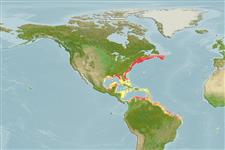Teleostei (teleosts) >
Anguilliformes (Eels and morays) >
Congridae (Conger and garden eels) > Congrinae
Etymology: Conger: Latin, conger = conger (Ref. 45335).
More on author: Mitchill.
Environment: milieu / climate zone / depth range / distribution range
Ecology
Marine; demersal; oceanodromous (Ref. 51243); depth range 1 - 477 m (Ref. 5951), usually 75 - 150 m (Ref. 5951). Subtropical; 46°N - 16°S, 97°W - 5°W
Western Atlantic: Cape Cod in Massachusetts to northeastern Florida in USA and northern Gulf of Mexico. Reported in eastern Atlantic: St. Helena (Ref. 5288). Northwest Atlantic: Canada (Ref. 5951).
Size / Weight / Age
Maturity: Lm ? range ? - ? cm
Max length : 230 cm TL male/unsexed; (Ref. 7251); common length : 100.0 cm TL male/unsexed; (Ref. 3715); max. published weight: 40.0 kg (Ref. 7251)
Occurs from shallow inshore waters to depths of 477 m and up to 260 m in the Gulf of Maine (Ref. 7135). Benthic (Ref. 5951). Nocturnal predators (Ref. 93252). Feeds mainly on fishes, but also on shrimps and small shellfish. Commonly caught by anglers along piers, docks and jetties in middle Atlantic states.
Life cycle and mating behavior
Maturities | Reproduction | Spawnings | Egg(s) | Fecundities | Larvae
Robins, C.R. and G.C. Ray, 1986. A field guide to Atlantic coast fishes of North America. Houghton Mifflin Company, Boston, U.S.A. 354 p. (Ref. 7251)
IUCN Red List Status (Ref. 130435)
Threat to humans
Harmless
Human uses
Fisheries: minor commercial
Tools
Special reports
Download XML
Internet sources
Estimates based on models
Preferred temperature (Ref.
123201): 7.1 - 25.2, mean 19.7 °C (based on 61 cells).
Phylogenetic diversity index (Ref.
82804): PD
50 = 0.5000 [Uniqueness, from 0.5 = low to 2.0 = high].
Bayesian length-weight: a=0.00049 (0.00027 - 0.00088), b=3.25 (3.09 - 3.41), in cm total length, based on LWR estimates for this species & Genus-body shape (Ref.
93245).
Trophic level (Ref.
69278): 4.5 ±0.8 se; based on diet studies.
Resilience (Ref.
120179): Low, minimum population doubling time 4.5 - 14 years (Assuming tm>4).
Fishing Vulnerability (Ref.
59153): Very high vulnerability (90 of 100).
Climate Vulnerability (Ref.
125649): High vulnerability (60 of 100).
Nutrients (Ref.
124155): Calcium = 27.1 [15.1, 52.3] mg/100g; Iron = 0.781 [0.431, 1.338] mg/100g; Protein = 18.8 [15.9, 21.7] %; Omega3 = 0.284 [0.126, 0.807] g/100g; Selenium = 62.7 [30.7, 130.0] μg/100g; VitaminA = 9.12 [2.53, 34.69] μg/100g; Zinc = 0.384 [0.274, 0.565] mg/100g (wet weight);
